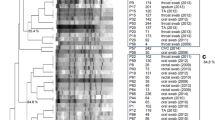Summary
Serological identification tests were carried out with many strains obtained from an otolaryngologic clinic, from oral cavities of dental patients and from other laboratories. The tests were performed through the slide agglutination method using monospecific or absorbed antisera based on the antigenic structures. The results of serological tests were compared with biological identifications. Since serological identifications alone were found to coincide well with the correlative identifications by biological and serological methods, it is concluded that the identification test using monospecific antisera, based on the antigenic structures of the genusCandida, is a useful and reliable method for a rapid identification of species.
Similar content being viewed by others
References
Kauffmann, F.: Enterobacteriaceae. 1954.
Boyd, J. S. K.: (1940). Laboratory diagnosis of bacillary dysentry. Trans. R. Soc. trop. Med.,33 553.
Tsuchiya, T., Fukazawa, Y., Miyasaki, F. &Kawakita, S.: (1955). Studies on the classification of the genus Candida. III. Thermostable and thermolabile antigens of the seven species of the genus Candida. Japan. J. exper. Med.,25 75.
Tsuchiya, T., Kamijo, K., Fukazawa, Y., Kawakita, S. &Nishikawa, Y.: (1956). Further studies on the classification of the genus Candida. V. Antigenic analyses of eight species. Japan. J. med. Sci. Biol.9 103.
Tsuchiya, T., Kawakita, S., Hayashi, S., Sato, I. &Takahashi, M.: (1957). Further studies on the classification of the genus Candida. VI. Antigenic Analysis of four species. Yokohama med. Bull.8 8.
Tsuchiya, T., Kamijo, K., Fukazawa, Y., Miyasaki, F. &Kawakita, S.: (1956). Studies on the classification of the genus Candida. IV. Relation of the isolated strains to the new antigenic structure. Yokohama med. Bull.,7 127.
Tsuchiya, T., Fukazawa, Y., Hayashi, S., Hayashi, J. &Doi, M.: (1957). Saccharomyces cerevisiae and Candida robusta. Japan. J. Microb.1 125.
Martin, D. S., Jones, C. P. Yao, K. F. &Lee, L. E.: (1937). A practical classification of the Monilias. J. Bact.,34 99.
Lodder, J. &Kreger-van Rij, N. J. W.: The Yeasts. A taxonomic study. 1952.
Yamashita, K.: (1956). Fungus problems in otolalyngology. J. Oto-rhinolaryngol. Soc. Japan,57 129.
Diddens, H. A. &Lodder, J.: Die anaskosporogenen Hefen. Zweite Hälfte, 1942.
Nickerson, W. J. &Mankowski, Z.: (1953) A polysaccharide medium of known composition favoring chlamydospore formation in Candida albicans. J. inf. Dis.,92 20.
Donomae, I.: (1955). Moniliasis. Shinryo,8 295. (in Japanese).
Tsuchiya, T. et al.: (1957). Studies on the classification of the genus Candida. Application of monospecific antisera in identification. Juntendo med. J.3 123. (in Japanese).
Benham, R. W.: (1931). Certain Monilias parasitic on man, their identification by morphology and by agglutination. J. inf. Dis.,49 183.
Weld, J. T.: (1952). “Candida albicans: Rapid identification in pure cultures with carbon dioxide on modified eosin-methylene blue medium.” A.M.A. Arch. Derm. Syph.,66 691.
Nickerson, W. J.: (1953) Reduction of inorganic substances by yeasts. J. inf. Dis.93 43.
Shapiro, E. M. Mullins, J. F. &Pinkerton, M. E.: (1956). Direct identification of Candida albicans on Littman's oxgall agar. J. invest. Dermat.,26 77.
Fahlberg, W. J., Dukes, C. D. &Guthrie, R. K.: (1957). Rapid classification of Candida (Monilia) albicans. J. invest. Dermat.,29 111.
Haley, L. D., &Stonerod, M. H.: (1955). A study of method used in the identification of Candida albicans. Amer. J. med. Tech., 304.
Tsuchiya, T., Fukazawa, Y., Hayashi, J., Nishikawa, Y. &Doi, M.: (1957). Serological classification of the genus Hansenula. Japan. J. Microb.,1 339.
Tsuchiya, T., Fukazawa, Y., Sato, I., Amemiya, S. &Murata, T.: (1958). Further studies on the classification of the genus Hansenula. Japan. J. exp. Med.,28 106.
Author information
Authors and Affiliations
Rights and permissions
About this article
Cite this article
Tsuchiya, T., Fukazawa, Y. & Kawakita, S. A method for the rapid identification of the genus Candida. Mycopathologia et Mycologia Applicata 10, 191–206 (1959). https://doi.org/10.1007/BF02053014
Issue Date:
DOI: https://doi.org/10.1007/BF02053014




